Branding Practices on Four Dairies in Kantale, Sri Lanka
Abstract
:Simple Summary
Abstract
1. Introduction
2. Description of Branding Practices
3. Welfare Implications
3.1. Restraint and Branding Methodology
3.2. Brand Size and Location
3.3. Pain Relief
4. Constraints to Uptake of Ear Tagging
4.1. Extensive Management System
4.2. Theft
4.3. Traditional Medicine
5. Alternatives
6. Conclusions
Author Contributions
Funding
Acknowledgments
Conflicts of Interest
References
- Schwartzkopf-Genswein, K.S.; Stookey, J.M.; Crowe, T.G.; Genswein, B.M.A. Comparison of image analysis, exertion force and behavior measurements for use in the assessment of beef cattle responses to hot-iron and freeze branding. J. Anim. Sci. 1998, 76, 972–979. [Google Scholar] [CrossRef] [PubMed]
- Schwartzkopf-Genswein, K.S.; Stookey, J.M.; de Passillé, A.M.; Rushen, J. Comparison of hot-iron and freeze branding on cortisol levels and pain sensitivity in beef cattle. Can. J. Anim. Sci. 1997, 77, 369–374. [Google Scholar] [CrossRef] [Green Version]
- Schwartzkopf-Genswein, K.S.; Stookey, J.M.; Welford, R. Behavior of cattle during hot-iron and freeze branding and the effects of subsequent handling ease. J. Anim. Sci. 1997, 75, 2064–2072. [Google Scholar] [CrossRef] [PubMed]
- Lay, D.C.; Friend, T.H.; Grissom, K.K.; Bowers, C.L.; Mal, M.E. Effects of freeze or hot-iron branding of Angus calves on some physiological and behavioral indicators of stress. Appl. Anim. Behav. Sci. 1992, 33, 137–147. [Google Scholar] [CrossRef]
- Lay, D.C.; Friend, T.H.; Bowers, C.L.; Grissom, K.K.; Jenkins, O.C. A comparative physiological and behavioral study of freeze and hot-iron branding using dairy cows. J. Anim. Sci. 1992, 70, 1121–1125. [Google Scholar] [CrossRef] [PubMed]
- Tucker, C.B.; Mintline, E.M.; Banuelos, J.; Walker, K.A.; Hoar, B.; Drake, D.; Weary, D.M. Effect of a cooling gel on pain sensitivity and healing of hot-iron cattle brands. J. Anim. Sci. 2014, 92, 5666–5673. [Google Scholar] [CrossRef] [PubMed]
- Tucker, C.B.; Mintline, E.M.; Banuelos, J.; Walker, K.A.; Hoar, B.; Varga, A.; Drake, D.; Weary, D.M. Pain sensitivity and healing of hot-iron cattle brands. J. Anim. Sci. 2014, 92, 5674–5682. [Google Scholar] [CrossRef] [PubMed]
- Department for Environment, Food, and Rural Affairs. The Mutilations (Permitted Procedures) (England) Regulations 2007; Department for Environment, Food, and Rural Affairs: London, UK, 2007.
- Ministry of Environment, Forest and Climate Change, Prevention of Cruelty to Animals (Regulation of Livestock Markets) Rules. In The Gazette of India: Extraordinary; Department of Publication, Ministry of Housing and Urban Affairs: Mumbai, India, 2017.
- World Horse Welfare and Eurogroup for Animals. Removing the Blinkers: The Health and Welfare of European Equidae in 2015. 2015. Available online: http://www.eurogroupforanimals.org/wp-content/uploads/EU-Equine-Report-Removing-the-Blinkers.pdf (accessed on 14 December 2017).
- Department of Census and Statistics. Livestock Population by Type and by District—2005–2017. 2017. Available online: http://www.statistics.gov.lk/agriculture/Livestock/LivestockPopulationSubnational.html (accessed on 14 March 2018).
- Ranaweera, N. Sri Lanka: Opportunities for dairy sector growth. In Smallholder Dairy Development: Lessons Learned in Asia; Morgan, N., Ed.; APHCA/FAO: Bangkok, Thailand, 2009; pp. 93–109. [Google Scholar]
- Chen, Y.; Stookey, J.; Arsenault, R.; Scruten, E.; Griebel, P.; Napper, S. Investigation of the physiological, behavioral, and biochemical responses of cattle to restraint stress. J. Anim. Sci. 2016, 94, 3240–3254. [Google Scholar] [CrossRef] [PubMed]
- Erber, R.; Wulf, M.; Becker-Birck, M.; Kaps, S.; Aurich, J.E.; Möstl, E.; Aurich, C. Physiological and behavioural responses of young horses to hot iron branding and microchip implantation. Vet. J. 2012, 191, 171–175. [Google Scholar] [CrossRef] [PubMed]
- Lay, D.; Friend, T.; Randel, R.; Bowers, C.; Grissom, K.; Jenkins, O. Behavioral and physiological effects of freeze or hot-iron branding on crossbred cattle. J. Anim. Sci. 1992, 70, 330–336. [Google Scholar] [CrossRef] [PubMed]
- Jiang, S.C.; Ma, N.; Li, H.J.; Zhang, X.X. Effects of thermal properties and geometrical dimensions on skin burn injuries. Burns 2002, 28, 713–717. [Google Scholar] [CrossRef]
- Pan, Y.S. Quantitative and morphological variation of sweat glands, skin thickness, and skin shrinkage over various body regions of Sahiwal Zebu and Jersey cattle. Aust. J. Agric. Res. 1963, 14, 424–437. [Google Scholar] [CrossRef]
- Muralidharan, M.R. Certain factors influencing the skin thickness in exotic cattle. Tamilnadu J. Vet. Anim. Sci. 2006, 2, 93–95. [Google Scholar]
- Adcock, S.J.J.; Tucker, C.B. Painful procedures: When and what should we be measuring? In Advances in Cattle Welfare; Tucker, C.B., Ed.; Elsevier: Duxford, UK, 2018; pp. 157–198. [Google Scholar]
- Olaifa, A.; Adeyemi, I. Epidermal wound contraction rates on different parts of the body of West African dwarf goats. J. Vet. Med. Surg. 2017, 1. [Google Scholar] [CrossRef]
- Goverman, J.; Mathews, K.; Goldstein, R.; Holavanahalli, R.; Kowalske, K.; Esselman, P.; Gibran, N.; Suman, O.; Herndon, D.; Ryan, C.M.; et al. Adult contractures in burn injury: A burn model system national database study. J. Burn Care Res. 2017, 38, e328–e336. [Google Scholar] [CrossRef] [PubMed]
- Garcia, L.G.; Nicholson, K.L.; Hoffman, T.W.; Lawrence, T.E.; Hale, D.S.; Griffin, D.B.; Savell, J.W.; VanOverbeke, D.L.; Morgan, J.B.; Belk, K.E.; et al. National Beef Quality Audit–2005: Survey of targeted cattle and carcass characteristics related to quality, quantity, and value of fed steers and heifers. J. Anim. Sci. 2008, 86, 3533–3543. [Google Scholar] [CrossRef] [PubMed]
- Lee, A.F.; Ryan, C.M.; Schneider, J.C.; Kazis, L.E.; Li, N.C.; Rose, M.; Liang, M.H.; Wang, C.; Palmieri, T.; Meyer, W.J., III; et al. Quantifying risk factors for long-term sleep problems after burn injury in young adults. J. Burn Care Res. 2017, 38, e510–e520. [Google Scholar] [CrossRef] [PubMed]
- Brusselaers, N.; Monstrey, S.; Vogelaers, D.; Hoste, E.; Blot, S. Severe burn injury in Europe: A systematic review of the incidence, etiology, morbidity, and mortality. Crit. Care 2010, 14, R188. [Google Scholar] [CrossRef] [PubMed] [Green Version]
- Ryan, C.M.; Lee, A.; Kazis, L.E.; Schneider, J.C.; Shapiro, G.D.; Sheridan, R.L.; Meyer, W.J.; Palmieri, T.; Pidcock, F.S.; Reilly, D.; et al. Recovery trajectories after burn injury in young adults: Does burn size matter? J. Burn Care Res. 2015, 36, 118–129. [Google Scholar] [CrossRef] [PubMed]
- Yeruham, I.; Perl, S.; Nyska, A. Skin tumours in cattle and sheep after freeze-or heat-branding. J. Comp. Pathol. 1996, 114, 101–106. [Google Scholar] [CrossRef]
- O’Toole, D.; Fox, J.D. Chronic hyperplastic and neoplastic cutaneous lesions (Marjolin’s ulcer) in hot-brand sites in adult beef cattle. J. Vet. Diagn. Investig. 2003, 15, 64–67. [Google Scholar] [CrossRef] [PubMed]
- Barua, C.; Talukdar, A.; Barua, A.; Chakraborty, A.; Sarma, R.K.; Bora, R.S. Evaluation of the wound healing activity of methanolic extract of Azadirachta Indica (Neem) and Tinospora cordifolia (Guduchi) in rats. Pharmacologyonline 2010, 1, 70–77. [Google Scholar]
- Kulac, M.; Aktas, C.; Tulubas, F.; Uygur, R.; Kanter, M.; Erboga, M.; Ceber, M.; Topcu, B.; Ozen, O.A. The effects of topical treatment with curcumin on burn wound healing in rats. J. Mol. Histol. 2013, 44, 83–90. [Google Scholar] [CrossRef] [PubMed]
- Srivastava, P.; Durgaprasad, S. Burn wound healing property of Cocos nucifera: An appraisal. Indian J. Pharmacol. 2008, 40, 144–146. [Google Scholar] [CrossRef] [PubMed]
- Eastern Provincial Council. Eastern Development Plan—2012–2016, Volume III: Sector Analysis. 2012. Available online: http://www.ep.gov.lk/Documents/EDP/EDP_Volume%20III%20a.Agricultural%20Development.pdf (accessed on 14 December 2017).
- Ediriweera, E.; Nanayakkara, N.; Kalawana, O.; Sugathadasa, Y. A review on traditional veterinary medical practices in Sri Lanka with special reference to cattle diseases. Trop. Agric. Res. Ext. 2010, 13, 55–62. [Google Scholar] [CrossRef]
- Stanford, K.; Stitt, J.; Kellar, J.A.; McAllister, T.A. Traceability in cattle and small ruminants in Canada. Rev. Sci. Tech. OIE 2001, 20, 510–522. [Google Scholar] [CrossRef]
- Canadian Cattle Identification Agency. National Tag Retention Project 2011–2015. 2016. Available online: http://www.canadaid.com/documents/Tag_Retention_Project_Final_Report_2016-EN.pdf (accessed on 19 June 2018).
- Caja, G.; Carné, S.; Salama, A.A.K.; Ait-Saidi, A.; Rojas-Olivares, M.A.; Rovai, M.; Capote, J.; Castro, N.; Argüello, A.; Ayadi, M.; et al. State-of-the-art of electronic identification techniques and applications in goats. Small Ruminant Res. 2014, 121, 42–50. [Google Scholar] [CrossRef]
- Ghirardi, J.J.; Caja, G.; Garín, D.; Hernández-Jover, M.; Ribó, O.; Casellas, J. Retention of different sizes of electronic identification boluses in the forestomachs of sheep. J. Anim. Sci. 2006, 84, 2865–2872. [Google Scholar] [CrossRef] [PubMed]
- Karakus, F.; Demir, A.Ö.; Akkol, S.; Düzgün, A.; Karakus, M. Performance of electronic and visual ear tags in lambs under extensive conditions in Turkey. Archiv Fuer Tierzucht 2015, 58, 287–292. [Google Scholar] [CrossRef] [Green Version]
- Johnston, A.M.; Edwards, D.S. Welfare implications of identification of cattle by ear tags. Vet. Rec. 1996, 138, 612. [Google Scholar] [CrossRef] [PubMed]
- Stewart, M.; Shepherd, H.M.; Webster, J.R.; Waas, J.R.; McLeay, L.M.; Schutz, K.E. Effect of previous handling experiences on responses of dairy calves to routine husbandry procedures. Animal 2013, 7, 828–833. [Google Scholar] [CrossRef] [PubMed]
- Ghirardi, J.J.; Caja, G.; Garín, D.; Casellas, J.; Hernández-Jover, M. Evaluation of the retention of electronic identification boluses in the forestomachs of cattle. J. Anim. Sci. 2006, 84, 2260–2268. [Google Scholar] [CrossRef] [PubMed]
- Wulf, M.; Aurich, C.; von Lewinski, M.; Möstl, E.; Aurich, J.E. Reduced-size microchips for identification of horses: Response to implantation and readability during a six-month period. Vet. Rec. 2013, 173, 451. [Google Scholar] [CrossRef] [PubMed]
- Caja, G.; Díaz-Medina, E.; Salama, A.A.K.; Salama, O.A.E.; El-Shafie, M.H.; El-Metwaly, H.A.; Ayadi, M.; Aljumaah, R.S.; Alshaikh, M.A.; Yahyahoui, M.H.; et al. Comparison of visual and electronic devices for individual identification of dromedary camels under different farming conditions. J. Anim. Sci. 2016, 94, 3561–3571. [Google Scholar] [CrossRef] [PubMed]
- Lindegaard, C.; Vaabengaard, D.; Christophersen, M.T.; Ekstom, C.T.; Fjeldborg, J. Evaluation of pain and inflammation associated with hot iron branding and microchip transponder injection in horses. Am. J. Vet. Res. 2009, 70, 840–847. [Google Scholar] [CrossRef] [PubMed]
- Wulf, M.; Wohlsein, P.; Aurich, J.E.; Nees, M.; Baumgärtner, W.; Aurich, C. Readability and histological biocompatibility of microchip transponders in horses. Vet. J. 2013, 198, 103–108. [Google Scholar] [CrossRef] [PubMed]
- Awad, A.I. From classical methods to animal biometrics: A review on cattle identification and tracking. Comput. Electron. Agric. 2016, 123, 423–435. [Google Scholar] [CrossRef]
- Lima, E.; Hopkins, T.; Gurney, E.; Shortall, O.; Lovatt, F.; Davies, P.; Williamson, G.; Kaler, J. Drivers for precision livestock technology adoption: A study of factors associated with adoption of electronic identification technology by commercial sheep farmers in England and Wales. PLoS ONE 2018, 13, e0190489. [Google Scholar] [CrossRef] [PubMed]
- Mutua, F.; Kihara, A.; Rogena, J.; Ngwili, N.; Aboge, G.; Wabacha, J.; Bett, B. Piloting a livestock identification and traceability system in the northern Tanzania–Narok–Nairobi trade route. Trop. Anim. Health Prod. 2018, 50, 299–308. [Google Scholar] [CrossRef] [PubMed]
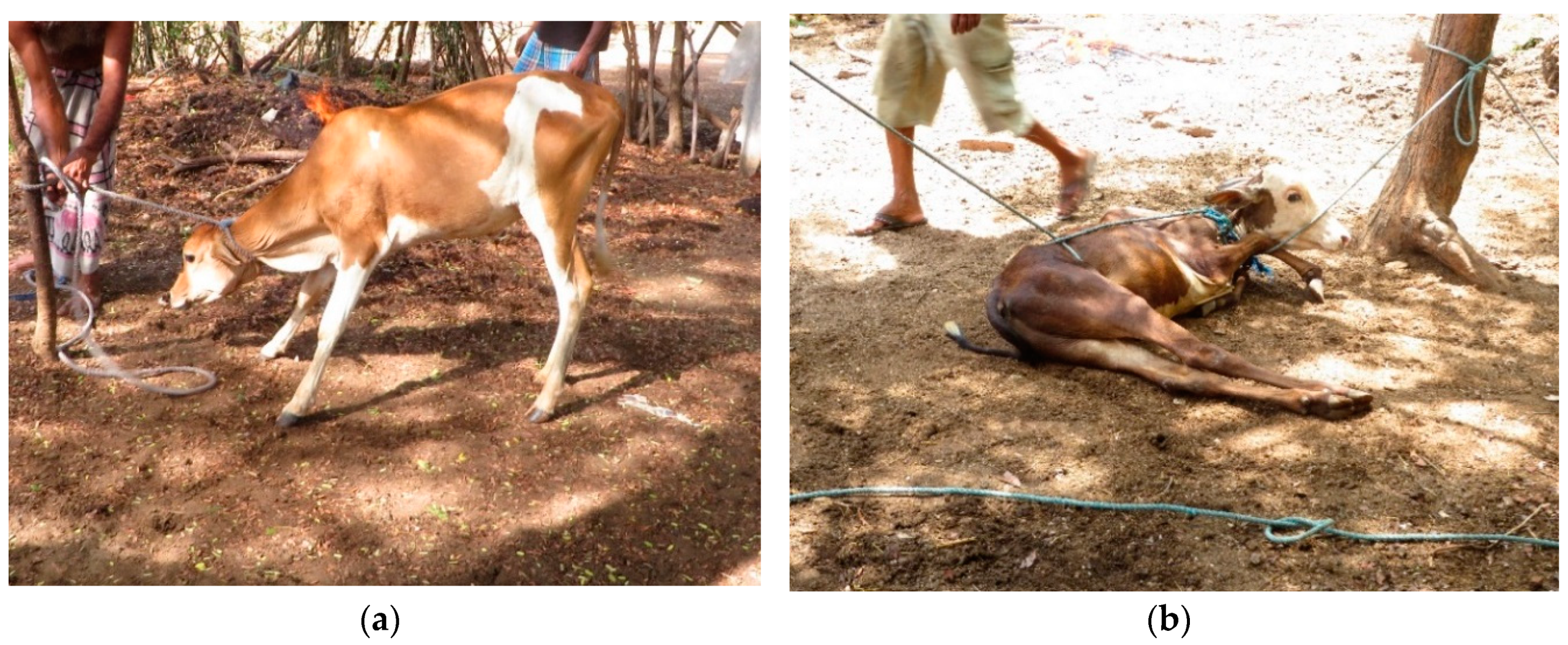
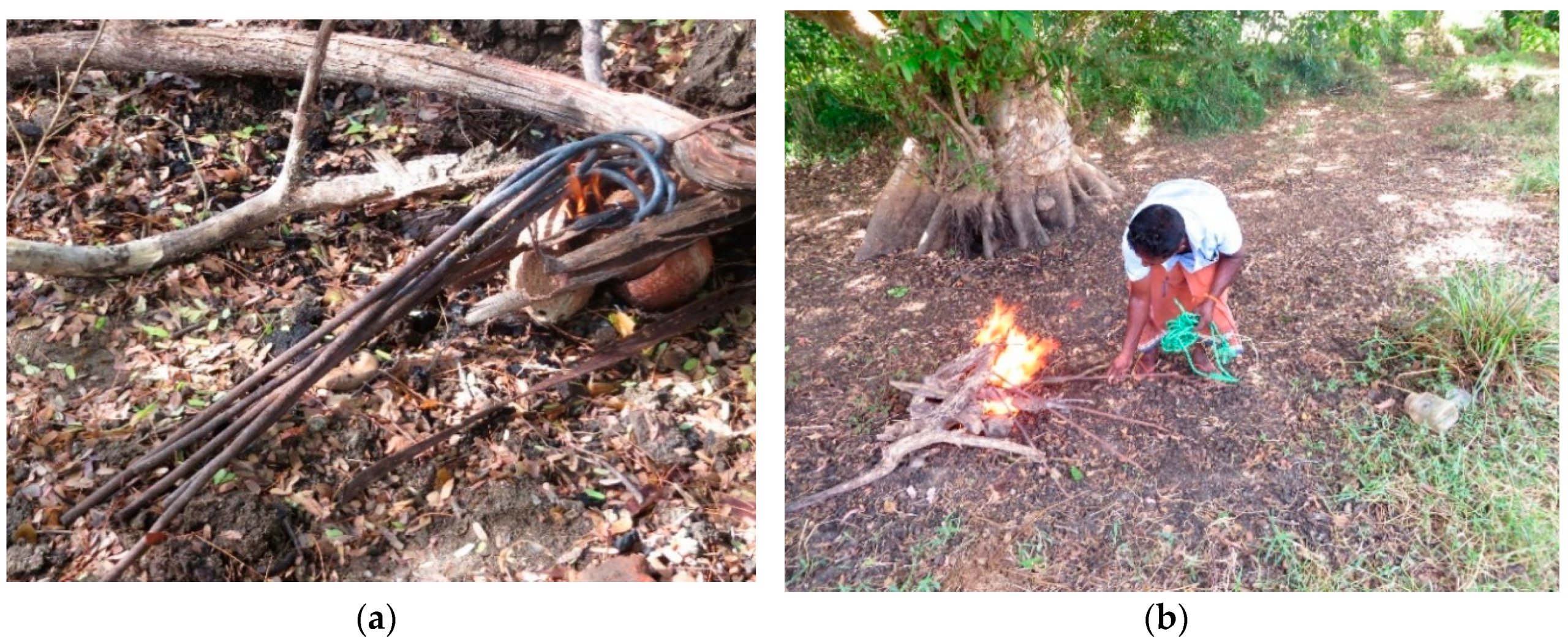
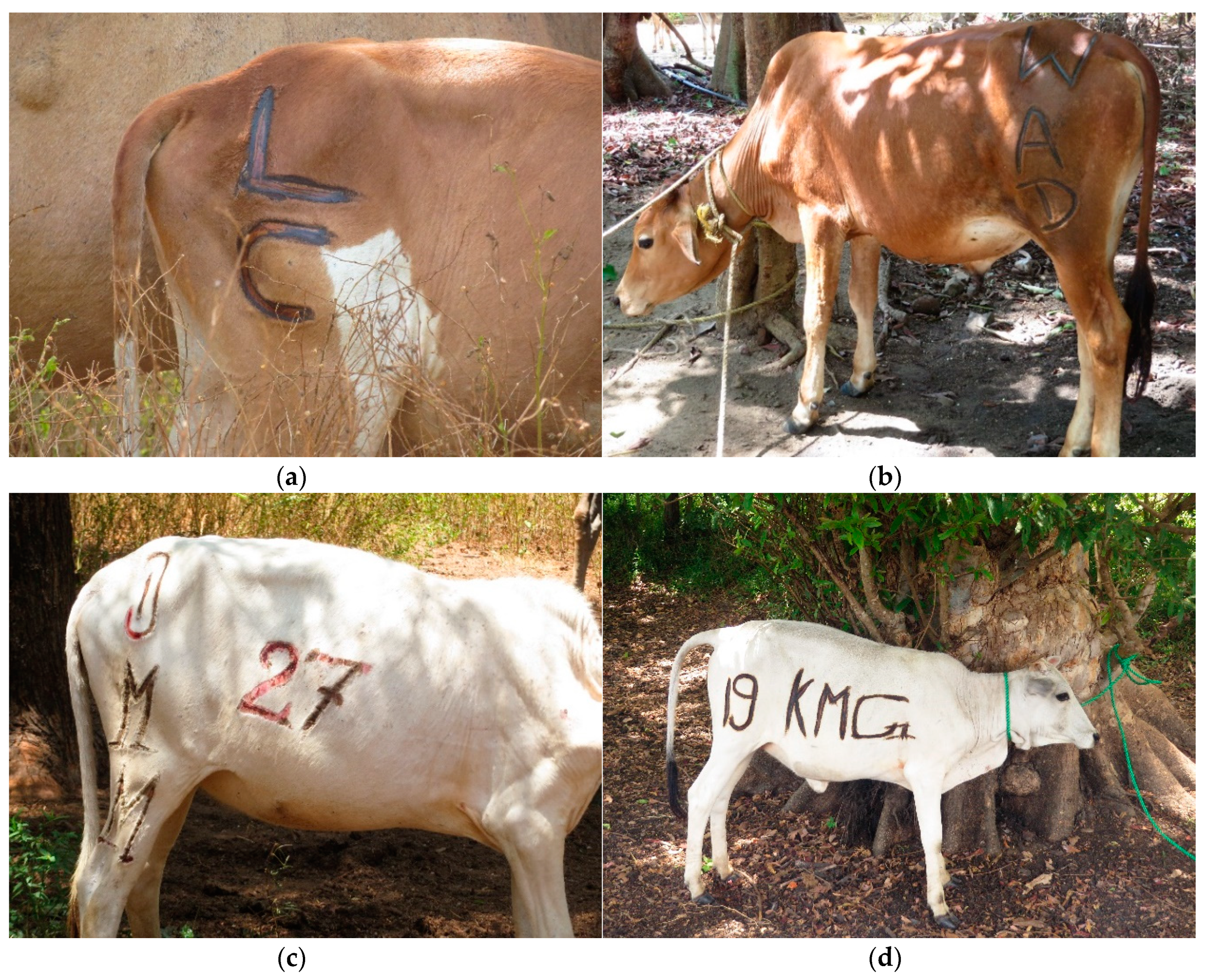
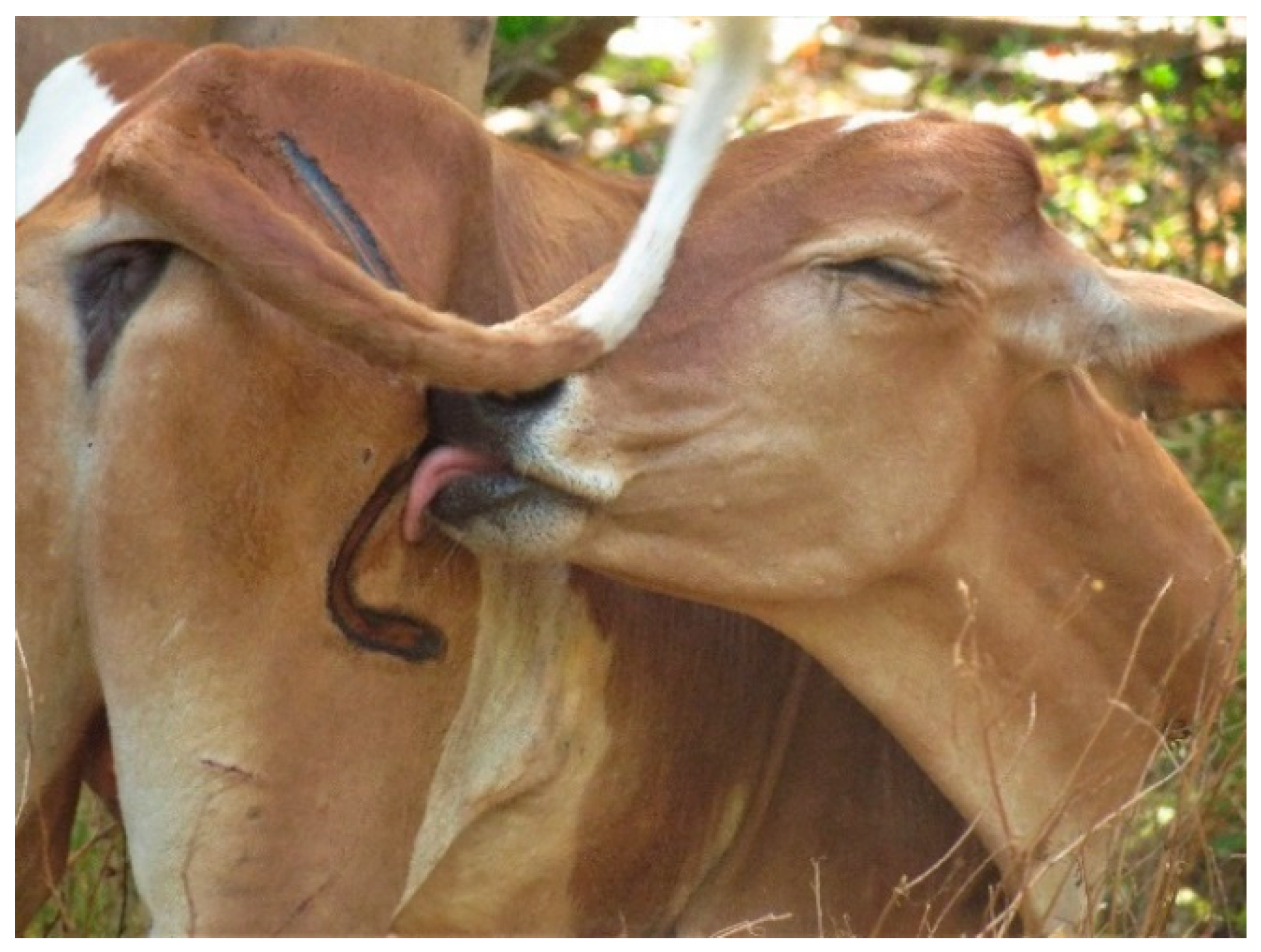
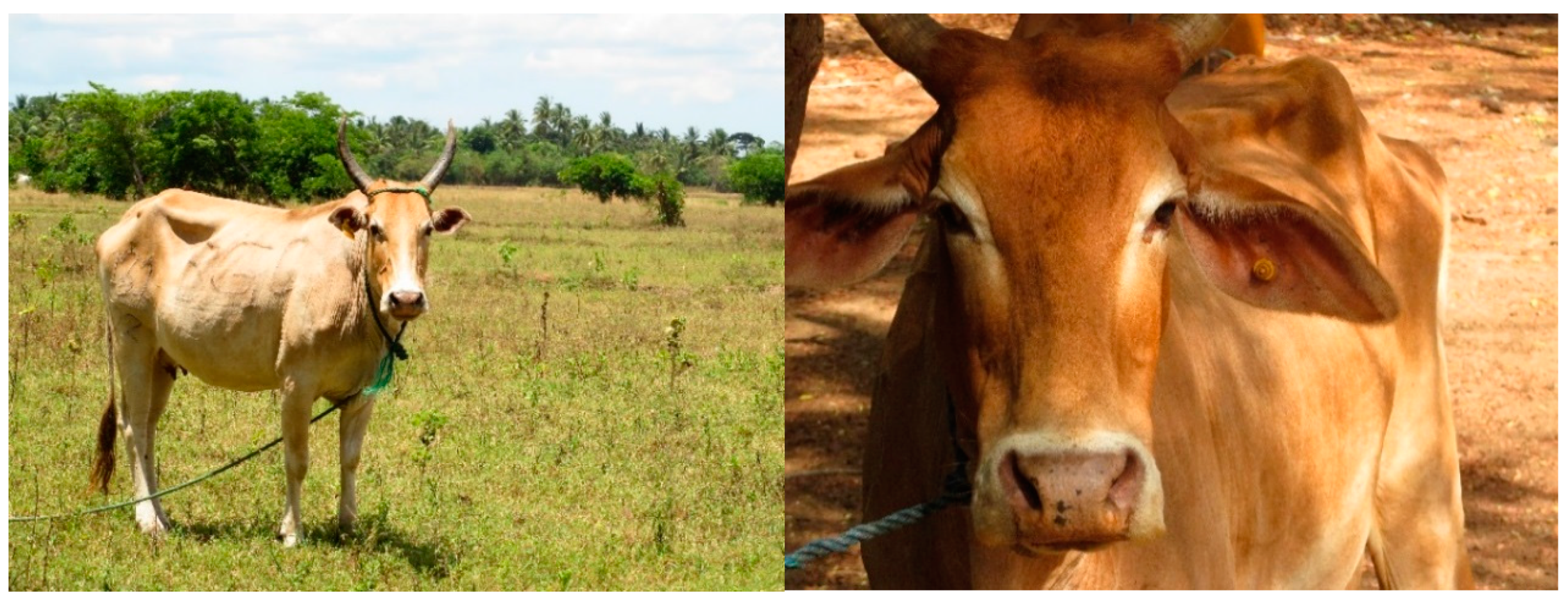
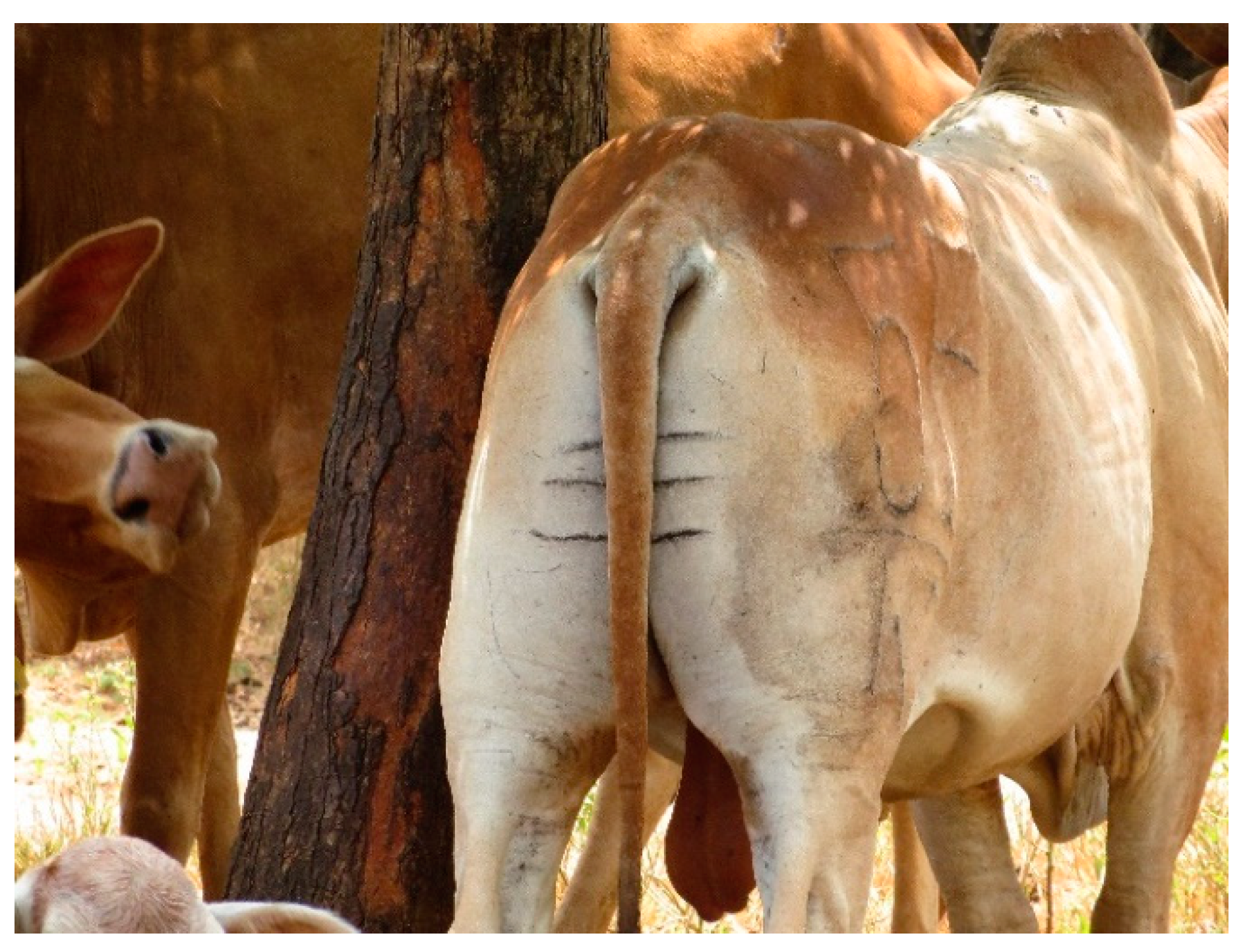
| Measure | Farm | |||
|---|---|---|---|---|
| 1 | 2 | 3 | 4 | |
| Age of animal (months) | 8 | 18 | 7 | 18 |
| Restraint method | Rope—legs not tied | Rope—legs not tied | Rope—legs tied | Rope—legs tied |
| Restraint duration (min) | 8 | 11 | 13 | 17 |
| Symbol | LC | WAD | DMM 27 | 19 KMG |
| Location of brand | Right upper and lower hip | Left upper and lower hip | Right upper and lower hip, rib, upper hindleg | Right upper and lower hip, rib |
| Pre-branding treatment | None | None | None | None |
| Post-branding treatment | Coconut oil & turmeric | Coconut oil, neem oil & turmeric | Coconut oil | None |
© 2018 by the authors. Licensee MDPI, Basel, Switzerland. This article is an open access article distributed under the terms and conditions of the Creative Commons Attribution (CC BY) license (http://creativecommons.org/licenses/by/4.0/).
Share and Cite
Adcock, S.J.J.; Tucker, C.B.; Weerasinghe, G.; Rajapaksha, E. Branding Practices on Four Dairies in Kantale, Sri Lanka. Animals 2018, 8, 137. https://doi.org/10.3390/ani8080137
Adcock SJJ, Tucker CB, Weerasinghe G, Rajapaksha E. Branding Practices on Four Dairies in Kantale, Sri Lanka. Animals. 2018; 8(8):137. https://doi.org/10.3390/ani8080137
Chicago/Turabian StyleAdcock, Sarah J. J., Cassandra B. Tucker, Gayani Weerasinghe, and Eranda Rajapaksha. 2018. "Branding Practices on Four Dairies in Kantale, Sri Lanka" Animals 8, no. 8: 137. https://doi.org/10.3390/ani8080137
APA StyleAdcock, S. J. J., Tucker, C. B., Weerasinghe, G., & Rajapaksha, E. (2018). Branding Practices on Four Dairies in Kantale, Sri Lanka. Animals, 8(8), 137. https://doi.org/10.3390/ani8080137





